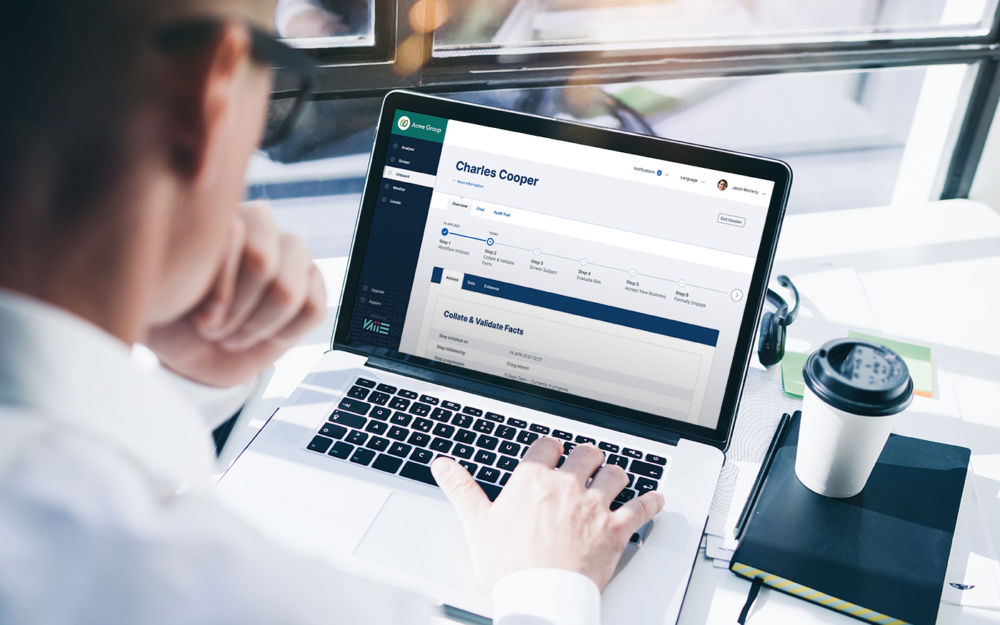Regulatory Technology – forging a new future of customer onboarding

Covid-19 has forced businesses to speed up their automation strategies.
It has even been said that automation will become key to surviving a possible Covid-19 recession. As we look to the future of financial services and navigating out of the pandemic, remote and automated client onboarding will be integral for any regulated business that wants to improve their customer experience, speed up compliance processes and reduce costs. However, what is critical in achieving true success with digital customer onboarding is balancing automation and usability with the ongoing and altering demands of the regulators.
A joint report from the World Bank and Cambridge Centre for Alternative Finance on the impact of Covid-19 on FinTech regulation delved into the sweeping view of the impact the pandemic has borne on the regulation of FinTech and regulatory innovation initiatives. Surveying 118 regulatory authorities across 114 jurisdictions, the comprehensive study overwhelming found that Covid-19 has only served to push RegTech up the agenda for regulators across the world. A fundamental internal challenge faced by one of the regulatory respondents was that working from home paused site visits to particular companies making it impossible in locations where there are strict containment/travel restriction measures to access necessary data and insights for compliance purposes. This shift has forced regulators and other authorities to accelerate initiatives to put concepts like digital identity verification or permitting electronic onboarding processes for customers into their manuals. The nuances however are evident between different jurisdictions. Whilst the JFSC doesn’t currently differentiate between the use of recorded versus live video recording during remote customer onboarding for example, other regulators do and therefore it is imperative to seek a digital onboarding solution that accommodates factors that adhere to local and global legislation, which will also serve to future proof your business.
How do businesses keep up with jurisdictional nuances?
The continual increase in regulation in financial services is fast becoming unmanageable without the consideration of intelligent systems, mitigating, reminding and delivering key updates to compliance teams at the right time, particularly considering there are around 750 regulators globally issuing on average 201 daily regulatory alerts. With a wealth of ongoing regulatory change existing and continuing through the likes of MiFID II, Basel III, AMLD5, ISOSCO, ISO22022, Dodd-Frank II, or a local jurisdictional update to the Jersey AML handbook, the terminology of text-based directives can be daunting even to the most seasoned compliance and financial services professionals.
Historically, a simple workflow process would be sufficient to provide enhanced levels of efficiency and risk assessment when onboarding a customer, however with the ongoing development of regulations, rising cyber security threats and the expectation towards using newer technologies to validate multiple points on a customer journey - the need to consider advanced digitised intelligent customer onboarding technology is getting more critical by the day.
The Financial Action Task Force (‘FATF’) says the impact of the Covid-19 pandemic, the resilience of national AML/CFT regimes and the risks faced by the private sector all vary significantly from country to country. The FATF have been highlighting the fact for some time that it is illogical to rely solely on a rating system available online to measure the accuracy of a risk assessment when onboarding a client. The methodology in which to assess all major risk elements needs to consider any jurisdiction a company operates in, therefore finding a customer onboarding solution that fully captures and considers global jurisdictional nuances in a timely and auditable manner, such as is seen with Vaiie Onboard, is paramount to reducing risk to your business.
One of the most effective aspects of a sophisticated digital customer onboarding tool is that it can be leveraged to identify the correct entities based on a variety of datapoints. This revolutionises the investigation into enhanced due diligence as something that historically has taken weeks and sometimes months for a report, but through the use of technology, can now be done in a matter of minutes.
Automated onboarding workflows
As we look to the future outlook of the compliance function, there is an evident shift emerging in viewing compliance as more than just a regulatory gatekeeper, and more as a service function integral to a business’s overall customer service experience, even using it as a competitive advantage.
The slow and complex customer onboarding process has become the achillies heel for both businesses and clients. In an ideal world, compliance departments should be reviewing already analysed data, providing them more time to evaluate, review and approve new business.
To counter threats from money laundering and Anti-Terrorism Financing, financial institutions must be able to identify the individual or entity and perform various checks to ensure the customer and their funds are legitimate. This also includes fulfilling a robust audit with full evidence, policy and procedures that compliance staff have undertaken. By having an inbuilt audit and reporting feature online throughout this process with all decisions made available in one single file makes any subsequent investigation or remediation much easier and improves transparency, validation and speed on decisions reached.
If now or in the near future you are not exploring the use of a digital onboarding workflow when conducting your due diligence as part of your customer onboarding, you will be;
- Limiting the quality and accuracy of information available to your business
- Requiring considerable time to be spent on reviewing your findings and removing any false positives
- Forced to rely on your existing sources therefore limiting your compliance function’s capability
By utilising a secure and compliant digital customer onboarding tool, such as Vaiie Onboard, you can now profile and onboard a customer in under five minutes, a drastic improvement to the manual process or the many non-compliant systems available in the market. Your over engineered internal processes can be transformed into an efficient, controlled and managed digital process.
Future of opportunity
By providing cutting edge technology through your systems to your clients, you will become more efficient, affordable and provide valuable additional resources to what matters the most; compliance review and approvals, strategy, customer satisfaction, relationship management, reporting, brand and continual growth.
Vaiie Onboard offers a hassle-free customer onboarding experience compatible on any internet enabled device, speeding up the enrolment process whilst still remaining extremely user friendly and easy to implement. After all, if customers don’t find a RegTech solution easy to use, they will find ways around it, adoption will lag and that critical return on investment will suffer, as well.
Drive down the cost of compliance by simplifying and standardising your compliance processes through automated mapping of regulatory risks to key business processes, thereby reducing the need for manual and duplicate checks. Not only will this provide your business with growing revenue, but also provide regulatory clarity and most importantly, continue to exceed customer expectations with service delivery
Article first appeared in Business Life Issue 73 on page 34.

